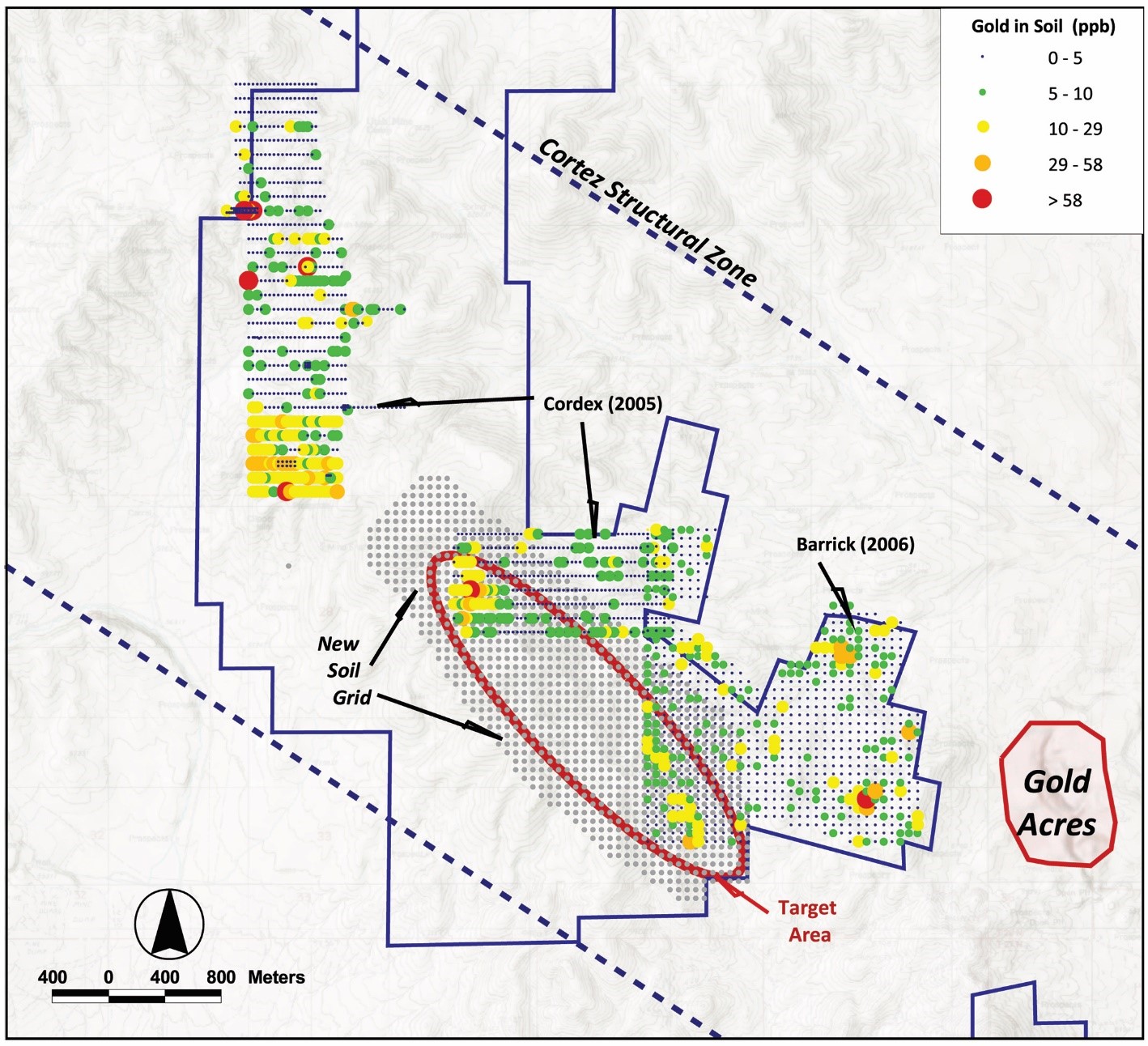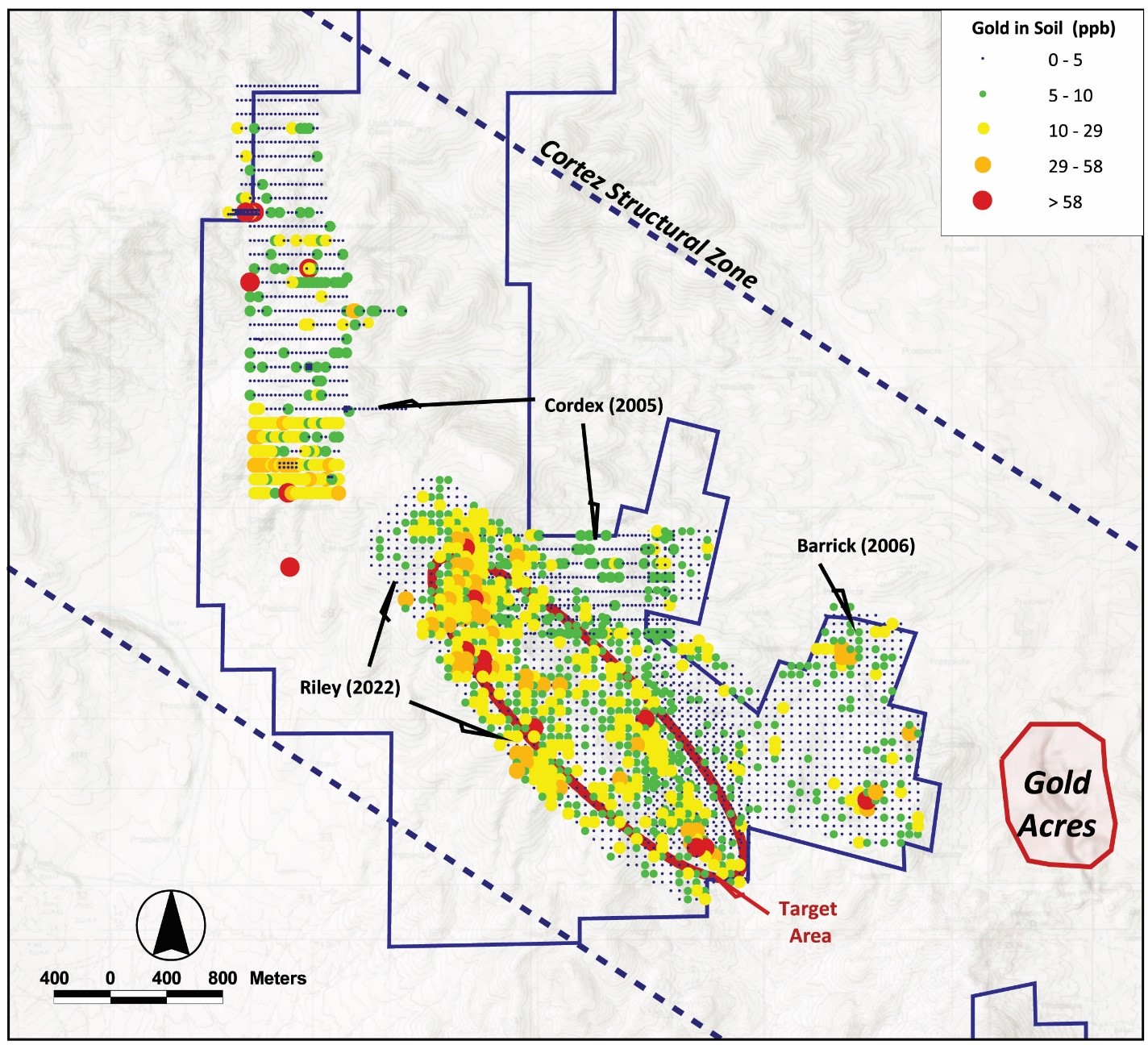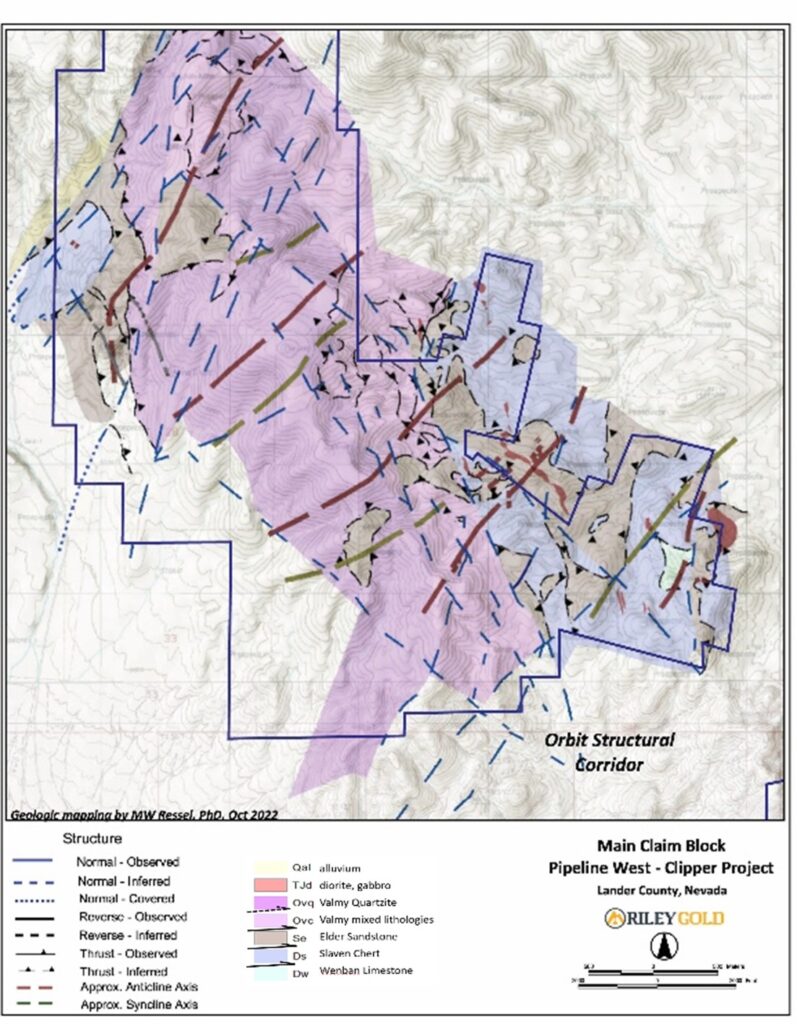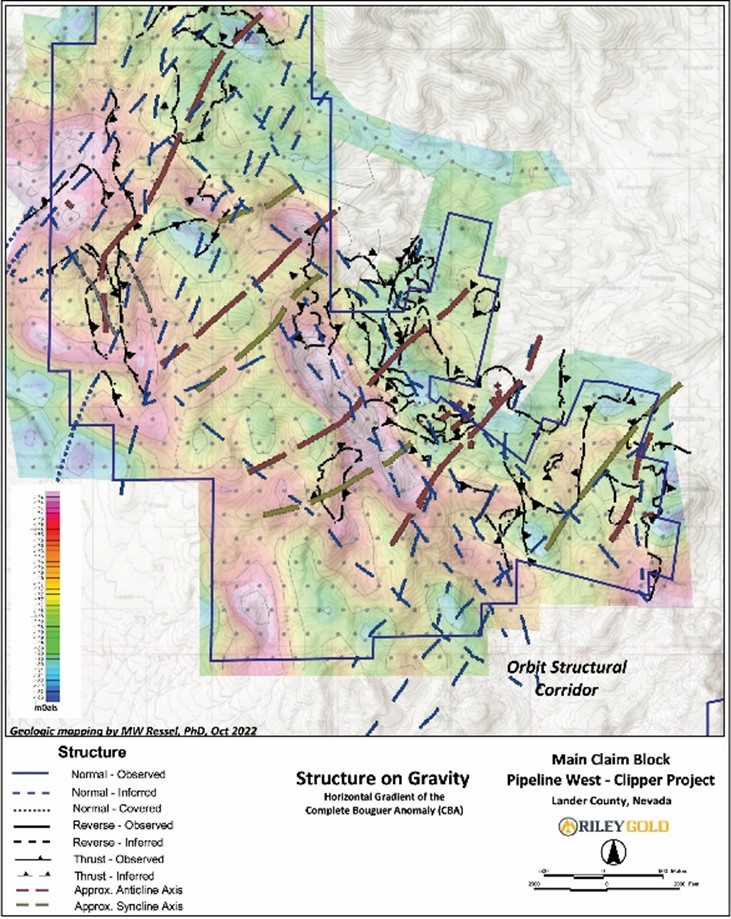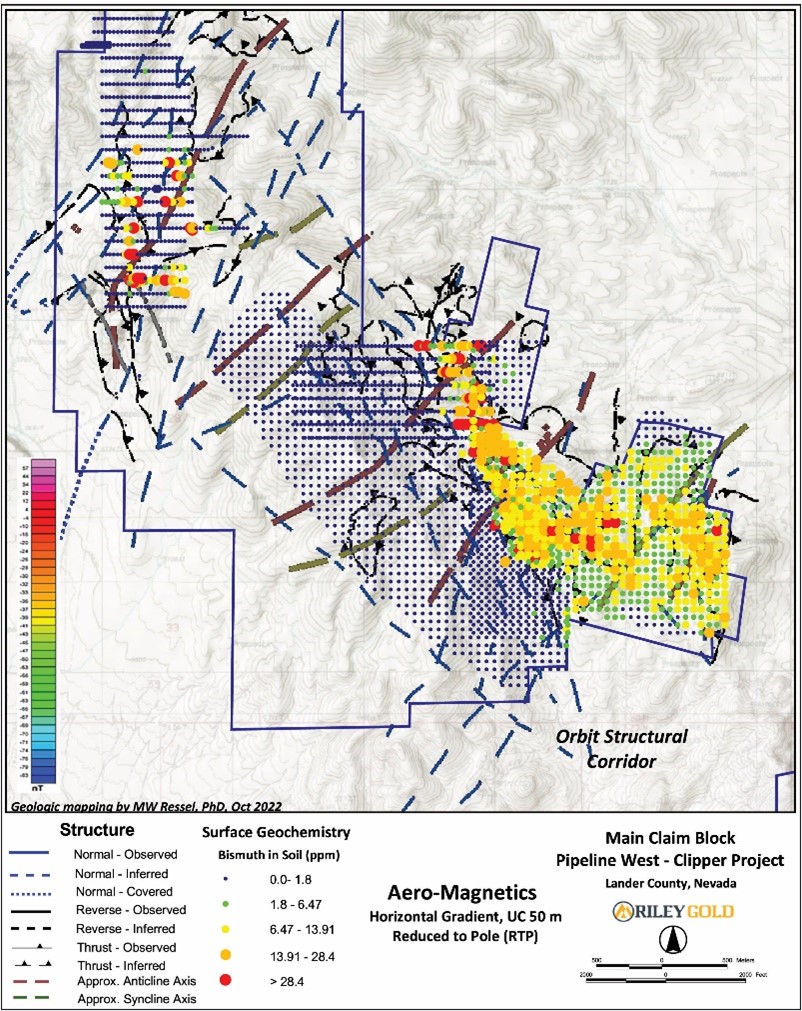Exploration Results Define High-Priority Drill Target Areas
Vancouver, B.C. February 8, 2023 – Riley Gold Corp. (TSX.V: RLYG) (OTCQB: RLYGF) (“Riley Gold” or the “Company”) is pleased to announce results of its Fall 2022 exploration program for its Pipeline West/Clipper Gold Project (“PWC”) located in Lander County, Nevada. The exploration program focused on a large soil geochemical program, extensive field mapping, and a re-interpretation of geophysics. PWC consists of approximately 24.7 square kilometres (“sqkm”) in the heart of the Cortez District segment of the Battle Mountain – Eureka Trend and adjoins Nevada Gold Mines LLC (“NGM”), which is a joint venture between Barrick Gold Corp. and Newmont Corporation.
Highlights
- Riley Gold has defined new high-priority drill target areas that have never been tested at PWC;
- Analytical results from the recently completed extensive soil survey identified significant anomalous gold-in-soil values extending more than 3 kilometres (“km”); Several pathfinder elements, associated with both Carlin-type and intrusive-related gold deposits, were also elevated;
- Re-interpreted Gravity, CSAMT, and Aero-Magnetic geophysical surveys support the new soil results;
- Recent geologic mapping provides a supporting structural foundation for the new soil results and geophysical survey interpretations;
- A drill plan is currently being developed for a maiden drill program expected in 2023.
“We are pleased to report successful results from our Fall/Winter 2022 exploration work at PWC and are excited to continue those initiatives into 2023. Our goal was to fill in critical gaps of project information and augment historical data, which has never been done within the PWC project. Our soil sampling program returned significant gold-in-soil results, as well as elevated pathfinder elements over a 3 km strike length. This zone is directly on trend with NGM’s Cortez Complex that currently has more than 18 million ounces of gold resource*. Additionally, our extensive re-interpretation of previous geophysical surveys, combined with the exciting results from our new soil sampling, will help us model high quality drill targets,” commented Todd Hilditch, CEO of Riley Gold.
Soil Survey Program:
As announced on December 1, 2022, a total of 1,046 soil samples (Figure 1 below – new soil grid) were collected at PWC and submitted to American Assay Laboratories of Sparks, Nevada for gold and multi-element geochemical analysis. North American Exploration, of Layton, Utah conducted the 3.8 sqkm soil program. The survey was designed to expand historical soil survey coverage. Previous soil surveys contained open-ended gold-in-soil anomalies within the PWC prospective target area (depicted by the red ellipse Figure 1). The soil program infilled areas lacking soil sampling coverage and yielded excellent results.
Figure 1: Historical Soil Surveys (parts per million “ppm”), New Riley Gold Soil Grid Survey Area & Postulated Target Area.
Soil Results:
Figure 2 (below) shows the new gold-in-soil results overlain on the older surveys. Gold is strongly anomalous compared to older surveys. The results of the survey also revealed that arsenic, antimony, silver, and other pathfinder metal anomalies were not only confirmed by new sampling over older sampling grids, but revealed new, even stronger values in areas not previously sampled. This target area has never been drilled.
Figure 2: Gold-in-Soil Results (ppm)
Geologic Mapping Supports Geophysical and Structural Interpretations as well as New Soil Results:
During October 2022, Mike Ressel, PhD, conducted geologic mapping at PWC. His mapping identified several structures of similar attitudes as earlier geophysical interpretations made by Chet Lide of Zonge International, Reno, NV (refer to Riley Gold press release dated April 28, 2022). Additionally, the geological mapping provides a sound foundation for interpretation of Riley Gold’s recent soil geochemical survey.
As shown in Figures 3 & 4, the new geology map highlights the northwest trending structural zone originally interpreted from the horizontal gradient (HG) of Complete Bouguer Anomaly (CBA) gravity. Another structural corridor, this trending northeasterly, coincides with similar features first interpreted from both horizontal gradient of the CBA gravity and the first vertical derivative of the Reduced to Pole (RTP) magnetics. Similar orientations of faults are recognized to control Carlin-type gold mineralization at the nearby Gold Acres-Pipeline mines.
Figure 3: Recent Geological mapping
Figure 4: New structure, as-mapped, on the horizontal gradient (HG) of the Complete Bouguer Anomaly (CBA) Gravity
In Figure 5 below, the gold-in-soil values (ppm) are overlain on geology. The anomalies coincide with a northwesterly structural trend from the southeast corner of the postulated target zone northwest through the center of the target area. This structural corridor, named the Orbit structural zone, was a fluid migration pathway and may play host to structurally controlled Carlin-type gold mineralization.
Figure 5: Gold-in-Soils on geology
Another, even stronger gold-in-soils anomaly appears at structural intersections and along a lithologically controlled zone within Ordovician Valmy quartzite. The quartzite, being brittle and subject to greater fracturing, may also provide fluid migration pathways for metals rising above deeper target zones in Antler lower-plate carbonate rocks that are the primary host strata for Carlin-type deposits in northern Nevada. Results for arsenic, antimony, and mercury show similar patterns. For details on arsenic and other Carlin-type pathfinder geochemistry refer to the Riley Gold Corp website (rilerygoldcorp.com).
An additional consideration at PWC is that of silver, base metals, and bismuth anomalies related to reduced, intrusion-related gold systems. This signature dominates areas of hornfels and skarn alteration peripheral to the ~105 million year old (Ma) Gold Acres stock. By way of comparison, hornfels proximal to the Tenabo stock show similar metal associations and host 1.3 million ounces in the measured and indicated gold resources plus 1.1 million ounces in inferred gold resource at NGM’s Robertson property only 4 km from PWC*. At PWC, there is a marked boundary between hornfelsed and carbon-rich rocks, based on geochemistry, aero-magnetics, and CSAMT (resistivity), as well as some older drill information. That boundary also coincides with mapped northwesterly trending structures in the Orbit structural corridor. Figure 6 (below) clearly shows that boundary as it is marked by a strong bismuth anomaly.
Figure 6: Bismuth in soil and lithics on structure.
Geochemical results (historic and current) from the soil and lithic chip sampling, combined with our detailed review of prior geophysical surveys, and historic drilling to the east and north of Riley Gold’s 3 km long target trend (red ellipse in Figure 2), will be modeled with the new mapping to help delineate specific drill targets. For a more in-depth review of Riley Gold’s exploration results, please refer to our website.
About Riley Gold Corp.
Riley Gold is an exploration and development company focused in Nevada, USA. The Company’s primary focus is on its two cornerstone assets: the Pipeline West/Clipper Project located in the Battle Mountain Eureka Trend (within the Cortez District) and the Tokop Gold Project located within the Walker Lane Trend. Riley Gold’s founders and leadership team have a proven track record of maximizing shareholder value during each phase of the mining life cycle: exploration, development, and production.
Qualified Person
This news release has been reviewed and approved by Charles Sulfrian, CPG., Exploration Manager, of Riley Gold and a ‘qualified person’, as defined by National Instrument 43-101, Standards of Disclosure for Mineral Projects.
FOR FURTHER INFORMATION, PLEASE CONTACT:
Todd Hilditch
Chief Executive Officer
Tel: (604) 443-3831
Neither the TSX Venture Exchange nor its Regulation Services Provider (as that term is defined in the policies of the TSX Venture Exchange) accepts responsibility for the adequacy or accuracy of this release.
*Resources and Reserves quoted from TECHNICAL REPORT ON THE CORTEZ COMPLEX, LANDER AND EUREKA COUNTIES, STATE OF NEVADA, USA; NI 43-101 TECHNICAL REPORT; Barrick Gold Corp for Nevada Gold Mines, effective date 31 December 2021.
Cautionary statement regarding forward–looking information
Certain disclosures in this release constitute “forward-looking information” within the meaning of Canadian securities legislation (such statements being referred to as “forward-looking statements”). Forward-looking statements are statements that are not historical facts and are generally, but not always, identified by words such as the following: expects, plans, anticipates, believes, intends, estimates, projects, assumes, potential and similar expressions. Forward-looking statements involve risks, uncertainties and other factors that could cause actual results, performance, prospects and opportunities to differ materially from those expressed or implied by such forward-looking statements, including statements regarding the exploration program at PWC, including results of historical drilling, sampling, geophysics, interpretations and future exploration plans at PWC including future drilling plans at PWC. Factors that could cause actual results to differ materially from these forward-looking statements include, but are not limited to, variations in the nature, quality and quantity of any mineral deposits that may be located, the Company’s inability to obtain any necessary permits, consents or authorizations required for its planned activities, and the Company’s inability to raise the necessary capital or to be fully able to implement its business strategies. The reader is referred to the Company’s public disclosure record which is available on SEDAR (www.sedar.com). Although the Company believes that the assumptions and factors used in preparing the forward-looking statements are reasonable, undue reliance should not be placed on these statements, which only apply as of the date of this news release, and no assurance can be given that such events will occur in the disclosed time frames or at all. Except as required by securities laws and the policies of the TSX Venture Exchange, the Company disclaims any intention or obligation to update or revise any forward-looking statement, whether as a result of new information, future events or otherwise.

